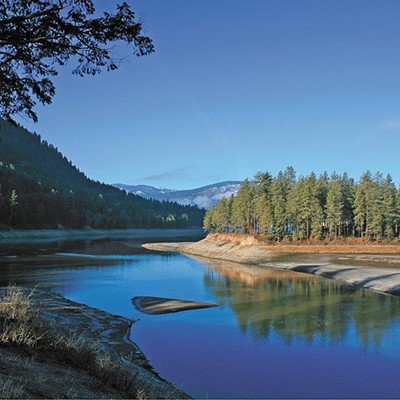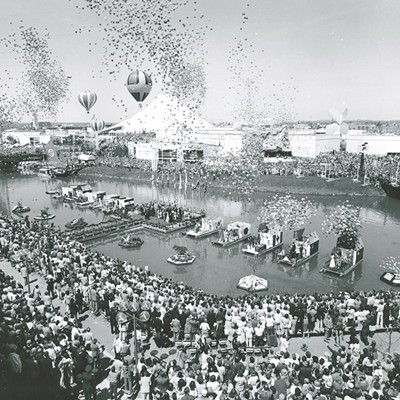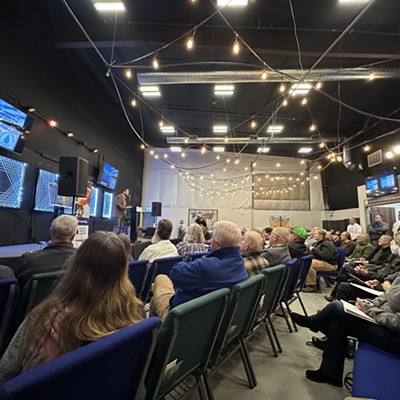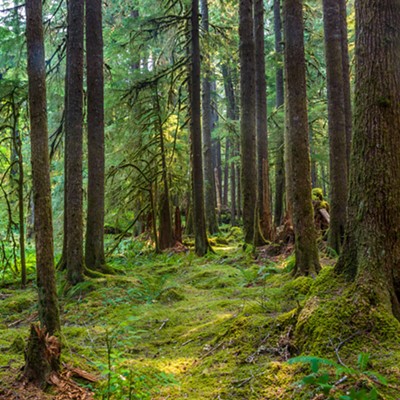There’s a stretch of road on Highway 200, as it nears the Idaho-Montana line in rural North Idaho, where the biggest traffic hazard is tourists parked on the side of the shoulder snapping pictures.
It’s there that the narrow ribbon of asphalt climbs from the muddy flats of the Pack River Delta and winds its way up onto the toes of the Cabinet Mountains. From that vantage point the huge southern sweep of Lake Pend Oreille can be seen, and the view can be just as distracting as the idling roadside motorists.
Like most scenic vistas, almost everybody’s pictures look the same, and it’s a safe bet that any panoramic shot taken down Pend Oreille’s northeastern shoreline will not only include water, trees and islands but a freight train chugging down the tracks that run along the water’s edge.
Trains are so much a part of the scenery that they go unnoticed. While Highway 200 sees a steady stream of cars and trucks traveling to and from nearby Montana, it runs parallel with one of the Northwest’s busiest rail lines. And through a confluence of much larger global forces — including Warren Buffett, economic growth in Asia and coal mined in Montana and Wyoming — those vacation snapshots could come to include a whole lot more trains.
Not everybody thinks the result will be too picturesque.
The Dirty Dance
Kally Thurman is an artist. She also makes a mean lentil soup and some of the best ham sandwiches you’ll ever eat. Her combination art gallery/café, Hope Marketplace, is something of a gathering place in the tiny sister hamlets of Hope and East Hope. Here, locals sit around funky tables and share news and gossip, warmed by the wood stove and surrounded by paintings.
Thurman’s business, which was a grocery store and filling station as far back as 1919, sits on the old highway and boasts a grandiose view of the lake. That view was maybe more grandiose before the new highway went in, but the tracks that run just across the street from her front door have always been there. Sit at the café for long enough and you’ll have a front-row seat to the never-ending shuttle of commodities between the Washington coast and the American interior.
“I don’t mind the trains,” Thurman says. “I find them mystical, especially in the morning and the fog.”
Ask how she would feel about a dramatic upswing in cars loaded with coal mined in Montana and Wyoming, and the mystical twinkle in her eye fades.
“That just makes me happy,” she says with evident sarcasm and a sigh. “But what are we going to do about it? It’s the dirty dance we gotta do. If we’re going to be a capitalism-based economy, that’s the dirty dance. I’d rather dirty-dance with Warren Buffett than Dick Cheney.”
Buffett would be pleased to hear that. True to his world-moving sense of opportunity, coal is a dirty dance that he’s more than happy to get down with — especially considering his main partners, China and India.
While climate-change concerns have prompted a national cold shoulder toward king coal in the United States, the ravenous industrial engines of the Pacific Rim and India have lost none of their appetite for combustible fossil fuels.
Despite the crippling international economic downturn, the U.S. Energy Information Administration noted that coal exports from the United States to Asia grew 176 percent from 2009 to 2010 — 17.9 million short tons’ worth. The stream of coal flowing from American mines to Asian industry is so great that if left unchecked, world coal consumption will actually increase by 2030, and 90 percent of that will be consumed by China, which burned 125.8 million tons in 2009 alone.
With a shaky domestic market, mining giants like Buffett’s Peabody Energy are looking to cash in, and the new boom is centered on the Powder River Basin, which straddles the Montana-Wyoming border southeast of Billings, Mont., and is home to the single-largest reserve of coal in the United States and one of the world’s richest deposits.
As Peabody CEO Gregory Boyce said in 2010, as quoted by Bloomberg, “The real goal here is to see if we can’t get large volumes of Powder River Basin coal to Asia. ... We know we can sell it in China and Korea.”
The big hurdle, however, is getting it there. And for that, you need a really, really big port. Make it two.
Boom Time
While energy industry execs have for years trumpeted the vast opportunities for coal exports to Asia, they only hinted at the challenge of shipping that much product. Starting in early 2011, it started to become much clearer that firms like Peabody and Arch Coal had their eyes on either acquiring or building coastal export terminals of their own — always with the explicit intention of using them to move product from the Powder River Basin.
According to figures cited in “Exporting Powder River Basin Coal: Risks and Costs,” a September 2011 analysis by the Western Organization of Resource Councils, Peabody’s increased exports “could mean an investment of as much as $500 million in new terminals.”
Buffett’s company is heavily involved in one such terminal near Cherry Point, Wash., termed the Gateway Pacific Terminal. Though still in the permitting process, and facing stiff opposition from residents and conservation groups in the region, Peabody has plans to build 24 million tons of coal capacity there with the ultimate goal of doubling that.
Arch, meanwhile, bought a stake in the Millennium Bulk Terminal near Longview, Wash. — across the Columbia River from Portland, Ore. — and plans to ship 5.7 million tons of coal per year. As in the case of the Gateway Pacific Terminal, that project is also under fire from a consortium of environmental groups.
With some of the biggest financial muscle in the world pushing the project on both ends, from the mines in the Powder River Basin to the ports on the coast, that leaves every community along the shipping route stuck in the middle. And perhaps nowhere is that more apparent than in the Inland Northwest, through which shipments — regardless of their destination port — will almost certainly be funneled.
The Funnel
Looking at a map of rail lines in the western United States, one is struck by two patterns. The web of tracks fan out from the Midwest and converge into two dense choke points in the Mountain West. One in Salt Lake City, a vast hub for the Union Pacific Railroad, and the other in the Idaho Panhandle — smack dab on Sandpoint, where not only UP but Burlington Northern-Santa Fe and the much smaller Montana Rail Link meet before hitting the central rail yard in Spokane, and heading west and south.
They call it “the funnel” and for good reason. About 50 trains, and sometimes as many as 70, travel through Sandpoint every day. The blare of horns is so commonplace that locals don’t even hear them and commuters often plan to be stopped at any of the more than 160 rail crossings located in Bonner County alone.
Should the coastal terminals open and coal shipments ramp up to meet an export market of 110 million tons per year, estimates cited in the WORC analysis suggest that rail traffic would need to increase by about 40-unit trains — some more than a mile-and-a-half long — traveling to or from the ports every day.
Along with that traffic would almost certainly come increased diesel emissions, wear and tear on the rail infrastructure and congestion, though officials with BNSF maintain the line through Sandpoint and Spokane has more than enough capacity to handle the traffic.
What really has environmental groups worried, though, are threats to air and water quality from the loads themselves. Some studies, including the WORC analysis, estimate that each coal car loses as much as 500 pounds of coal and dust, amounting to more than 30 tons per train, during each trip.
In the case of North Idaho, where the BNSF tracks run for miles along the northeastern shore of Lake Pend Oreille, that idea alone is starting to raise a ruckus.
“There’s a lot of significant things that people should be concerned about, but what we’re worried about are the impacts to the lake,” says Shannon Williamson, who heads the Lake Pend Oreille Waterkeeper organization. “The coal dust is quite significant, and when it flies off, it goes into the surrounding land and water. What’s worse, if there’s a derailment, it would be catastrophic. It would be horrific — like an oil spill — and that could be a real possibility.”
Even the rail companies admit that coal dust is a danger, though officials with BNSF, which is itself owned by Buffett’s mammoth Berkshire Hathaway, say the biggest threat stems from coal dust’s corrosive effect on the rails, not human health.
“At the origin location — the Powder River Basin — coal dust has posed a serious threat to the stability of our track,” says Texas-based BNSF spokeswoman Suann Lundsberg. “But starting Nov. 1, we’ve taken measures to reduce coal dust. What we’ve said is, ‘Shipper, you need to reduce your coal dust by 85 percent.’” That is being accomplished by a request that coal loads be packed in the shape of a bread loaf to keep material from blowing off the sides. Still, loads are not required to be covered — and it costs time and money to do so — and without sealing the cars, it’s inevitable that particulates and even chunks of coal will come loose.
That’s nothing to worry about either, Lundsberg says, unless you live near the mine.
“If you take a dusty book off the shelf and blow on it, dust blows off the first time. If you blow on it a second time, no dust blows off,” she says, adding that potential human health risks are “not something we’ve studied.”
However, doctors in Bellingham, Wash., have, and they stated that coal and coal dust do pose an environmental and health danger no matter how far from the “origin location” they travel. Lundsberg dismisses the study as inflated. “You can’t really compare health risks of miners with coal dust coming off of a car,” she says. “Where we have coal dust problems are in the Powder River Basin. We’ve never had a complaint in Washington state.”
Don’t Coal it a Comeback
The potentially sharp increase in coal shipments through the
Sandpoint-Spokane area has been a bit of a sleeper issue so far. While communities closer to the proposed export terminals have hosted numerous panels and information sessions, it wasn’t until last October that any public outreach on the topic had been attempted in the Spokane area.
Hosted by the Spokane Riverkeeper, the information session covered potential environmental and health risks, along with a discussion of how increased rail traffic could affect the region.
“Here on the route there’s a major lack of education,” says Riverkeeper Bart Mihailovich. “They say, ‘Oh, the trains are going to Longview or Bellingham, who cares?’”
The other educational hurdle is that neither the terminals nor the subsequent coal shipments are impending.
Even if the permitting and environmental impact statements go through without a hitch, it would be at least five years before the region would feel any impacts from the surge in exports.
Lundsberg, with BNSF, stresses that nothing involving expanded shipments from the Powder River Basin or freight loads to the proposed coastal terminals has been solidified.
“It’s just way, way, way too early to even talk about that stuff,” she says. “It’s simply too soon to know what the market demands will be, and we don’t have a contract for any freight that goes into the Gateway Pacific Terminal.”
Still, groups like the Pend Oreille Waterkeeper, Spokane Riverkeeper, Sierra Club and Power Past Coal are mounting their first resistance as the EIS process begins in earnest.
The Sierra Club, in particular, thinks it’s a big enough deal to position someone in Spokane to keep an eye on the process and help spur area residents to action.
“Cities along the coal rail route like Bellingham, Edmonds and Spokane, are waking up,” says Crystal Gartner, associate field organizer for the Sierra Club in Spokane. “They’re concerned they don’t have a say because they’re out of the scope of the study. It would be worse for Spokane because all the rails go through here, yet we have zero say in what happens.”
Like other coal-shipment opponents, Gartner ticks off a list of potential dangers, from diesel emissions to coal and coal dust, to congestion and derailment. She also doubts communities along the possible route would see any economic benefit.
“Coal trains bring only harm ... no benefit. Not one single job,” she says. “Basically, we’d be another sacrifice zone for the mining companies. Why should we let Big Coal ram this down our throats and threaten our quality of life?”
Protecting the region’s quality of life means getting a seat at the table, and that’s a priority for Mihailovich as well.
“Right now, we’re in the wait-and-see period,” he says. “Statewide groups in Washington have put pressure on the governor’s office to include this area in the EIS, as well as Bellingham and Longview. It should cover the whole region along the route.”
Consideration of the plan should also mean looking at the larger impacts, Mihailovich says, including its contribution to global greenhouse gas emissions.
According to figures cited in Science Daily and quoted in the WORC analysis, the export of 20 million to 30 million tons of Powder River Basin would result in the export of between 35 million and 53 million tons of carbon dioxide per year. A full 110-million-ton export market would add 220 million tons of CO2 to the atmosphere annually.
“That’s the larger education, and it’s a little harder to quantify — it’s even harder to do,” Mihailovich says. “We’re trying to tie this into a larger context.”
With the filing of an application for the Cherry Point Terminal near Bellingham expected this month, and the EIS process gearing up shortly thereafter, Williamson, with the Pend Oreille Waterkeeper, is also tracking the issue and working with fellow opponents to ensure potential impacts in North Idaho are considered in the process as well.
“The Sierra Club and others are advocating for a longer public comment period on the EIS. They’re usually 30 days but that can totally slip under a lot of people’s radar. We want 90 days to comment on the EIS,” Williamson says. “The effect on our community needs to be reflected, too.”
Gartner, at the Sierra Club, agrees. “Spokane, Sandpoint and other cities along the rail line will see nothing but harm and no benefits from Big Coal’s massive coal export proposal,” Gartner says. “We can’t trust the railroads or the coal companies to protect our communities. They’ll talk a big game, but when it comes down to it, they just want to make a big buck off the health and safety of our communities.
“We are talking to community members, doctors, ministers, business owners and public officials about the risks this proposal poses to our community and opportunities this spring to let their voices be heard and make sure their community is represented in the process.”
Looking out her window at the Hope Marketplace, Thurman remembers her experiences in China during the 1980s.
“I’ve been to the Gary, Ind., of China — Baotou in Inner Mongolia — and it was like going back to the 19th century,” she says. “The only Anglos there were from Pittsburgh, and they were selling coal-burning equipment. We’re hopefully the last generation that’s going to use it.”
Whether it’s coal dust in Montana, degraded tracks in Hope, congestion and diesel emissions in Washington or CO2-belching smokestacks in China, Williamson says there’s nothing to like about the plan.
“It
does absolutely nothing except cause damage, and I think everybody can
find something to be concerned about this,” she says. “The only good
news I can think of is that this isn’t completely imminent. There is
some time to really raise some hell.”
A version of this article first appeared in Boise Weekly.






















